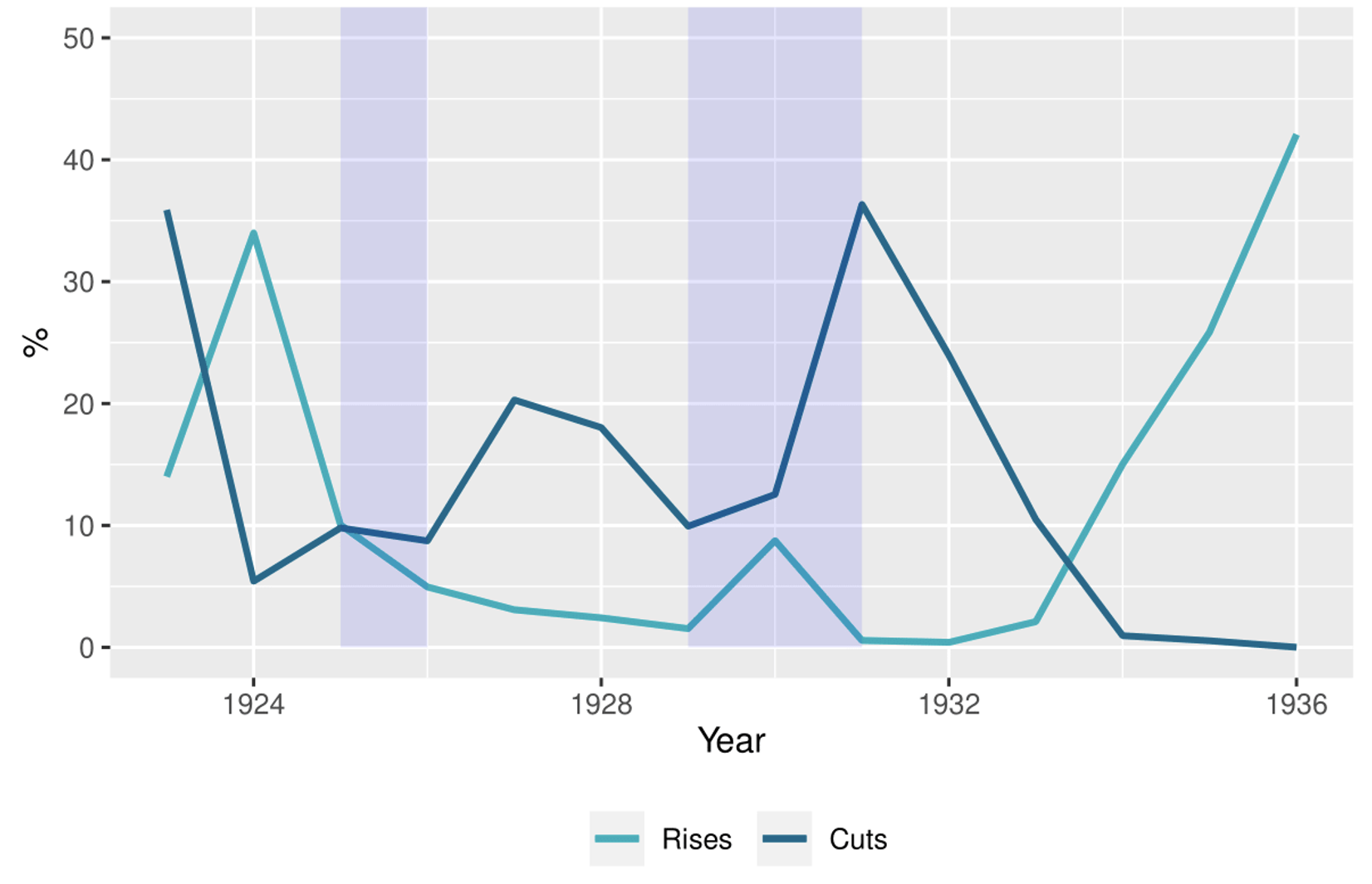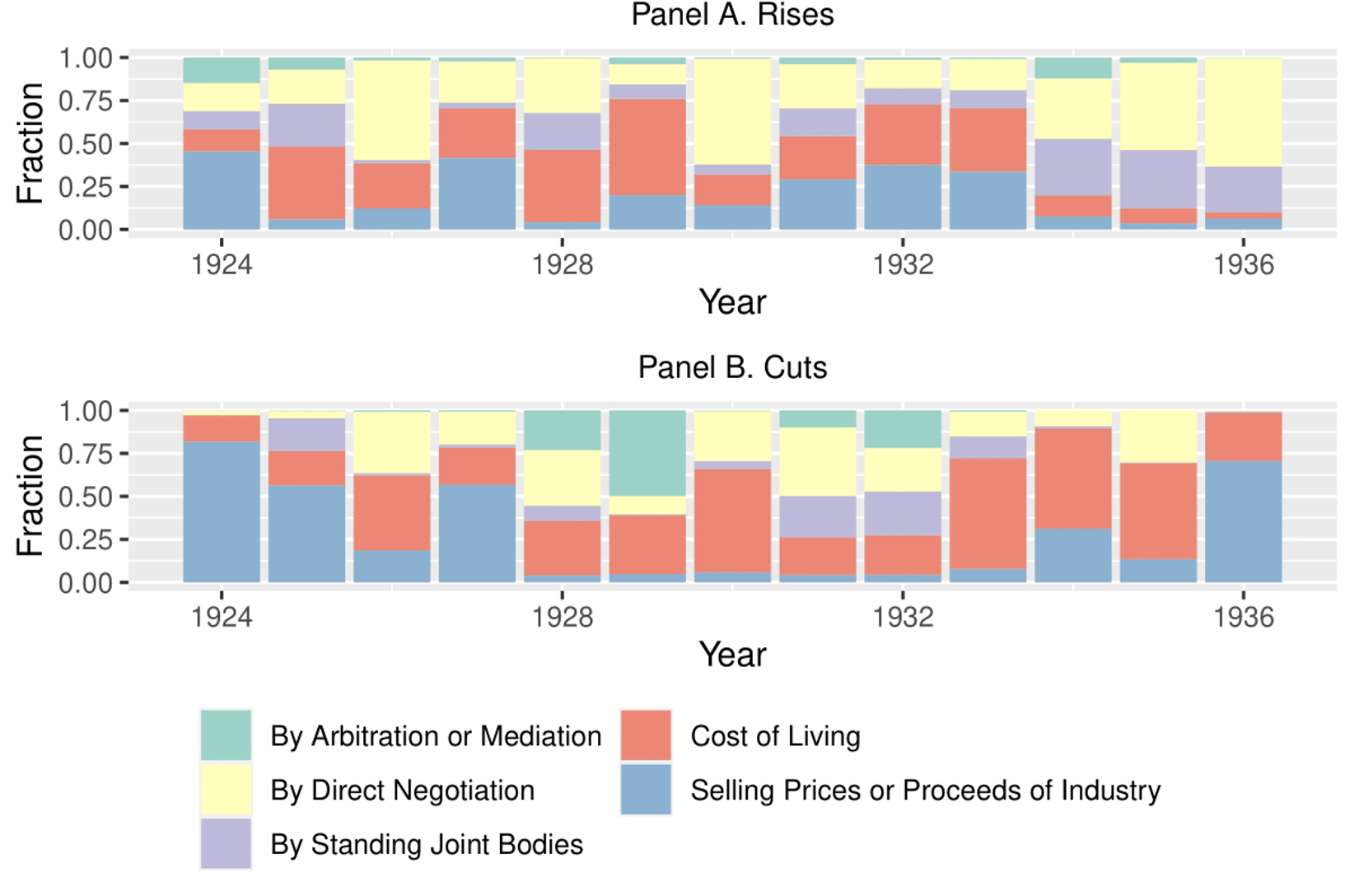How wages adjust to shocks is a question for the ages. Today, the concern is that prices are rising more than nominal wages, leading to lower real wages and a cost-of-living crisis. In the 1930s – a mirror for many modern macroeconomic challenges – the issue was reversed. According to the textbook account, prices fell more than nominal wages, resulting in higher real wages, mass unemployment, and the Great Depression (Bernanke 1995).
Yet our understanding of nominal wage rigidity during the Great Depression is not perfect. Many existing studies use macro data on average wages, which tangles multiple sources of variation into a single statistic.
In new research (Lennard, forthcoming), I document the first estimates of nominal rigidity in interwar Britain that are comparable to those for modern economies using micro data on millions of wages from primary sources.
Data
The source is The Ministry of Labour Gazette, which “compiled returns collected by the Ministry of Labour from employers and their associations, trade unions, and other sources” (Ministry of Labour 1937). While the individual returns have seemingly been lost, the key moments that underpin modern analyses of sticky wages can be calculated from the information that survives. Despite the promise of this data, economic historians have not exploited it before.
The frequency of nominal wage adjustment
Using this data, the unconditional probability of a wage change was 27.7% a year. Put differently, 72.3% of workers had their wages frozen on average each year. This implies that nominal wages remained fixed for 3.6 years on average.
But the critical issue – in some macroeconomic models (Dupraz et al. 2021) and in the historiography – is not the overall level of nominal wage rigidity but the level of downward rigidity. As a result, I plot the fraction of wage cuts and rises in Figure 1. On average, the frequency of pay rises was 11.8% a year; the frequency of pay cuts was 13.8% a year.
Figure 1 The share of employees receiving rises and cuts in nominal wages, 1923-36
Notes and sources: This figure shows the frequency of rises and cuts in nominal wages in the US between 1923 and 1936. The series have been calculated using information from the Ministry of Labour (1937) and Department of Employment and Productivity (1971). The shaded areas represent recessions from Broadberry et al. (2022).
During the key period of the Great Depression, there were masses of wage cuts. Between 1930 and 1932, the average frequency of cuts was 24.3%, of which 12.5% of employees received reduced pay in 1930, 36.3% in 1931, and 24% in 1932. To put these numbers into context, the wage cuts in 1931 alone affected more than 3 million workers. Added to this misery was the disappearance of pay rises. In 1930, just 0.6% of employees had the good fortune of a raise, falling to 0.4% in 1931.
Although comparisons are not straightforward, interwar Britain stands out for both its paucity of pay rises – an annual rise is the norm in modern economies but occurred every 8.5 years on average a century ago – and for its plentiful pay cuts, which were more frequent in the UK during the Great Depression than in the US during the Great Recession (Grigsby et al. 2021) – a model of labour market flexibility.
The magnitude of nominal wage adjustment
When contracts were altered, the changes in pay were non-trivial. The average wage rise was 6.2%; the average cut was 6.8%, which is further evidence that wages were no stickier down than up. During the Great Depression, rises shrank in size, while cuts grew. In 1931, for example, the average rise was 5.6%; the average cut was 6.9%.
Accounting for stickiness
Why were some wages sticky? Although it is challenging to identify causal effects, I consider a range of possible explanations. There is some evidence of a rigid floor for nominal wages arising from institutional sources: nominal minimum wages were more sticky than actual nominal wages during the Great Depression and unemployment benefits for females and males aged 21 to 64 were unchanged between April 1928 and the outbreak of the WWII. There is also evidence that strikes prevented wage adjustment. The numbers striking over wage questions increased from less than 38,000 in 1927 and 1928 to 440,000 in 1929 and persisted above 156,000 until 1932. The vast majority of these grievances were over wage decreases.
Means of adjustment
The reverse of why some wages were sticky is why others changed. To answer this question, I use the returns filed to the Ministry of Labour (1937), which enumerated “the methods by which changes in rates of wages were arranged.” Figure 2 plots the means by which nominal wages were adjusted upwards and downwards. On average, the most common method for securing a pay rise and a pay cut was the sliding scale, of which linking wages to “selling prices or the proceeds of industry” was slightly more prevalent than to the “cost of living.” The least common was by arbitration or mediation.
Figure 2 The means of adjusting nominal wages, 1924-36
Notes and sources: This figure shows the means of adjusting nominal wages in the UK between 1924 and 1936. The series have been calculated using information from the Ministry of Labour (1937).
Conclusions
The 1930s offer useful insights for the present. First, institutions were a source of nominal rigidity, such as minimum wages and unemployment benefits, as nominal rates were not fully adjusted to changing conditions. Second, resembling this year’s ‘Summer of Discontent’, the incomplete adjustment of nominal wages coincided with strikes. Third, at a time of major shocks, the rigidity of nominal wages moderated with larger and more frequent adjustments.
References
Bernanke, B S (1995), “The Macroeconomics of the Great Depression: A Comparative Approach”, Journal of Money, Credit and Banking 27(1): 1–28.
Broadberry, S, J S Chadha, J Lennard and R Thomas (2022), “Dating Business Cycles in the United Kingdom, 1700-2010”, Economic Statistics Centre of Excellence Discussion Paper.
Carlsson, M, J Messina and O N Skans (2016), “Firms’ productivity and workers’ wages: Swedish evidence”, VoxEU.org, 23 October.
Department of Employment and Productivity (1971), British Labour Statistics: Historical Abstract 1886-1968, Her Majesty’s Stationery Office.
Dupraz, S, E Nakamura and J Steinsson (2021), “A Plucking Model of Business Cycles”, NBER Working Paper No. 26351.
Faia, E and V Pezone (2019), “Monetary policy and the cost of wage rigidity: Evidence from the stock market”, VoxEU.org, 12 March.
Grigsby, J, E Hurst and A Yildirmaz (2021), “Aggregate Nominal Wage Adjustments: New Evidence from Administrative Payroll Data”, American Economic Review 111(2): 428–71.
Leitao, M, J Montana and J Silva (2022), “How firms reduce wage inequality”, VoxEU.org, 17 August.
Lennard, J (forthcoming), “Sticky Wages and the Great Depression: Evidence from the United Kingdom”, European Review of Economic History.
Ministry of Labour (1937), Twenty-Second Abstract of Labour Statistics of the United Kingdom (1922-1936), His Majesty’s Stationery Office.





